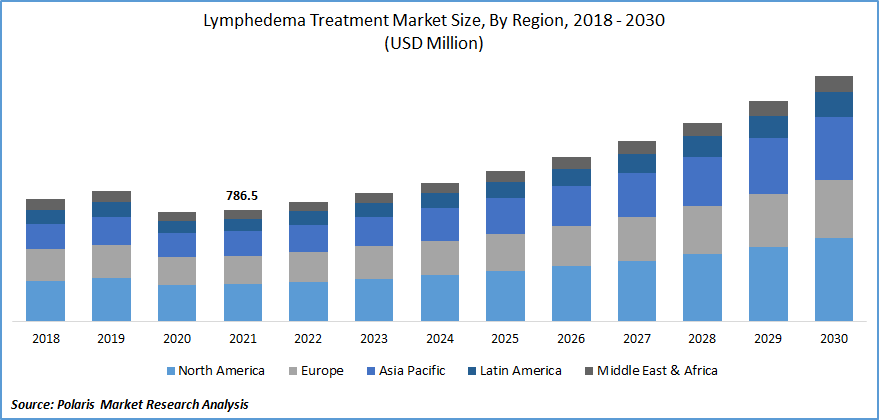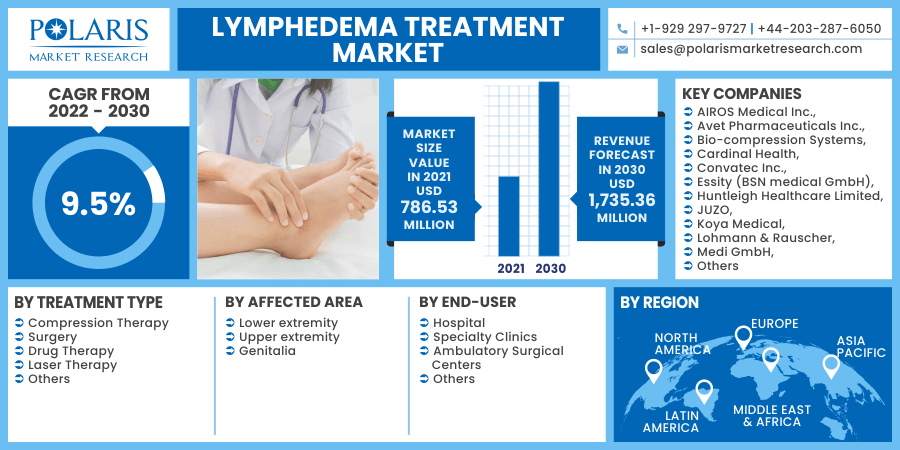
Lymphedema Treatment Market Share, Size, Trends, Industry Analysis Report, By Treatment Type, By Affected Area, By End-User (Hospital, Specialty Clinics, Ambulatory Surgical Centers, Others), By Region; Segment Forecast, 2022 - 2030
- Published Date:Mar-2022
- Pages: 118
- Format: PDF
- Report ID: PM2314
- Base Year: 2021
- Historical Data: 2018 - 2020
Report Outlook
The global lymphedema treatment market was valued at USD 786.53 million in 2021 and is expected to grow at a CAGR of 9.5% during the forecast period. Lymphedema is a disease that enlarges a body part abnormally due to Lymphostasis caused by the dysfunction of the Lymphatic system. The increasing prevalence of Lymphedema and other chronic diseases such as Cancer that causes this disease is anticipated to drive the growth of the global lymphedema treatment market.
 Know more about this report: request for sample pages
Know more about this report: request for sample pages
Furthermore, the increasing healthcare expenditure and technological developments are expected to boost the market's growth. The impact of the COVID-19 outbreak is far-reaching, having adverse effects on communities, individuals, and societies globally. People suffering from chronic health conditions are at a greater risk of contracting and experiencing complications from COVID-19.
The growing investments towards developing a vaccine for COVID-19 and the rising spending towards patient treatment are anticipated to hinder the investments towards the research activities in the Lymphedema treatment market. Due to the outbreak, research and academic institutions have delayed or halted their research activities in this field. Further, the decline in corporate spending and government support is anticipated to hinder the lymphedema treatment market's growth over the coming years.

Know more about this report: request for sample pages
Industry Dynamics
Growth Drivers
The rising prevalence of Lymphedema cases globally is anticipated to drive the market's growth. Furthermore, the increasing number of cancer cases is likely to offer tremendous market growth opportunities. According to the U.S. Department of Health & Human Services, Lymphedema can occur in cancer patients due to the onset of disease or treatments that affect Lymph node drainage. For instance, this disease can occur within days or take up to 30 years after breast cancer treatment. Further, 80% of the patients suffer the onset within 3 years of the surgery.
Moreover, a large number of patients, especially women, suffer from lower limb Lymphedema after gynecologic cancer treatment, with a low prevalence (7%) among ovarian cancer survivors and a high majority (37%) among vulvar cancer survivors. Additionally, the incidence of arm Lymphedema ranges from 7-56% two years post-surgery.
According to the ACOSOG (Alliance Z 1071 longitudinal substudy of the American College of Surgeons Oncology Group), in breast cancer trials, patients report the incidence of arm heaviness and swelling after three years of the surgery. These factors are driving the prevalence of Lymphedema, thus fuelling the growth of the global lymphedema treatment market.
Report Segmentation
The market is primarily segmented on the basis of treatment type, end-user, and region.
|
By Treatment Type |
By Affected Area |
By End-User |
By Region |
|
|
|
|
Know more about this report: request for sample pages
Insight by End User
Hospital segment is recorded to hold the most significant revenue in 2021 and is expected to lead the market in the forecasting years. The considerable share of the segment can be attributed to the large number of patients coming directly to the hospital for diagnostic and treatment of Lymphedema.
Furthermore, the rising adoption of minimally invasive procedures coupled with the increasing adoption of innovative and advanced treatments is anticipated to drive the segment's growth. Additionally, the growing number of hospitals offering Lymphedema treatments across emerging economies is expected to provide substantial growth opportunities for the development of the segment.
The Specialty Clinics segment is projected to have the highest CAGR in the forecasting years. The fast growth of the segment can be attributed to the fact that treatments for Lymphedema are primarily offered in specialized units or centers. Specialized surgical therapies, including debulking and liposuction, are performed in specialty clinics with a dedicated department for lymphedema treatment. Additionally, the increasing number of specialty clinics globally is anticipated to boost the market's growth.
Geographic Overview
Geographically, North America accounted for the largest revenue share in the global market in 2021. The rising technological advancements in the healthcare sector are anticipated to drive the market's growth in North America. The increasing awareness regarding IgG4 related diseases is expected to offer tremendous market growth opportunities.
The high prevalence of Lymphedema across the US is anticipated to drive the market's growth. Furthermore, the high prevalence of chronic diseases such as cancer that leads to secondary Lymphedema is expected to drive the market's growth in North America. For instance, according to CDC's (Center for Disease Control & Prevention) Cancer Data & statistics, over 1,708,921 new cancer cases were reported in the US.
Moreover, the Asia Pacific market is anticipated to exhibit progressive CAGR over the forecasting years. The fast growth of the segment can be attributed to the increasing prevalence of chronic diseases, improvement in healthcare infrastructure, and rising research initiatives by government & pharmaceutical companies pertaining to the development of innovative Lymphedema treatment methods.
Furthermore, the increasing number of hospitals and specialty clinics across emerging nations is anticipated to drive the market's growth. Emerging economies such as China, India, and Japan, among others, contribute to industry development. The presence of a large patient pool across the Asia Pacific is anticipated to fuel the market's growth. Additionally, the rising cancer cases in emerging nations are expected to propel industry growth. For instance, according to GLOBOCAN, in 2018, over 4,285,033 new cases were reported in China alone.
Competitive Insight
Some of the major players operating in the global lymphedema treatment industry include AIROS Medical Inc., Avet Pharmaceuticals Inc., Bio-compression Systems, Cardinal Health, Convatec Inc., Essity (BSN medical GmbH), Huntleigh Healthcare Limited, JUZO, Koya Medical, Lohmann & Rauscher, Medi GmbH, Mego Afek ltd., PAUL HARTMANN, SIGVARIS GROUP, Smith+Nephew HERANTIS PHARMA Plc, Tactile medical, and ThermoTek.
Lymphedema Treatment Market Report Scope
|
Report Attributes |
Details |
|
Market size value in 2021 |
USD 786.53 million |
|
Revenue forecast in 2030 |
USD 1,735.36 million |
|
CAGR |
9.5% from 2022 - 2030 |
|
Base year |
2021 |
|
Historical data |
2018 - 2020 |
|
Forecast period |
2022 - 2030 |
|
Quantitative units |
Revenue in USD million and CAGR from 2022 to 2030 |
|
Segments covered |
By Treatment Type, By Affected Area, By End-User, By Region |
|
Regional scope |
North America, Europe, Asia Pacific, Latin America; Middle East & Africa |
|
Key Companies |
AIROS Medical Inc., Avet Pharmaceuticals Inc., Bio-compression Systems, Cardinal Health, Convatec Inc., Essity (BSN medical GmbH), Huntleigh Healthcare Limited, JUZO, Koya Medical, Lohmann & Rauscher, Medi GmbH, Mego Afek ltd., PAUL HARTMANN, SIGVARIS GROUP, Smith+Nephew HERANTIS PHARMA Plc, Tactile medical, and ThermoTek.
|
